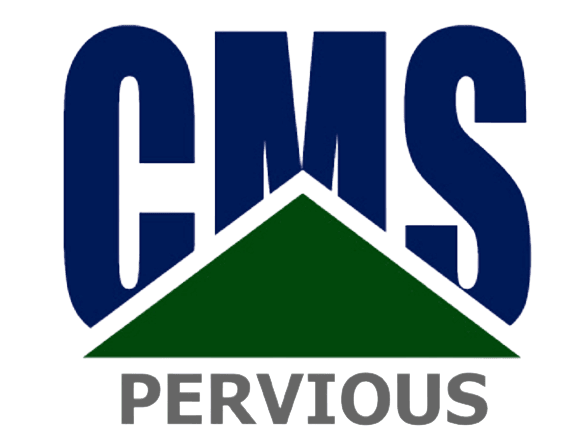CMS Pervious
The Leader in Pervious Concrete Solutions.
Pervious Concrete
What is it?
Pervious concrete is a durable concrete pavement with a large volume (approx. 20%) of interconnected voids.
Like conventional concrete, it is made from a mixture of cementitious materials, coarse aggregates, and water, typically containing little or no sand, which results in a porous open-cell structure that allows water to pass through readily.
When pervious concrete is used for paving, it can take in stormwater at a rate of several hundred or more inches of water per square foot per hour, which far exceeds the flow rate needed to prevent runoff in even the most severe rain events. In slow draining or clay soils, rainwater is temporarily stored in a stone layer underneath the pavement while it is allowed to naturally percolate slowly into the underlying soil, called a recharge bed.
Because the pavement and base layer act as detention areas to capture and infiltrate water, it can completely prevent the polluted site runoff that normally occurs with impervious pavements. A properly designed pervious concrete system can eliminate the cost of the conventional stormwater infrastructure with no need for bio-swales or rain gardens.Pervious concrete pavement systems are fully recognized as an EPA Stormwater BMP for both infiltration and treatment. As the water percolates through the open cells of the pavement and crushed rock base layer aerobic bacteria in the voids help to break down harmful pollutants and chemicals.
At CMS Pervious, we have proprietary mix designs that we use to customize pervious concrete for the available materials in most parts of the country. We can design the optimal mix design for your site and application.
Pervious pavement is easier to install than standard concrete if you understand what makes it work and how to avoid common (but expensive) mistakes. We proactively work with suppliers and installers to get them working as a team.
Photos and Videos of Great Pervious
FAQ's
Where Can Pervious Concrete Be Used?
Pervious concrete can be used in the place of conventional exterior pavements for parking lots, roads, driveways, walkways, sidewalks, paths, courtyards, and sports courts. It is suitable for light to heavy vehicle traffic at low to moderate speeds …
My Site Has Clay Soils; Will Pervious Concrete Work?
Yes! Using site-specific soil infiltration rates the pervious concrete system can be designed to compensate for slow draining soils. From the first flush to capturing all the impervious cover runoff, we can plan, model, and install a system that …
What Is The Expected Lifespan Of Pervious Concrete?
Same as traditional concrete, 30-50 years.
Won't It Clog? What About Maintenance?
A little bit of common-sense site design can go a long way towards avoiding any clogging issues. Runoff from adjacent areas laden with sediment should not be directed onto the pervious. Short of that normal debris from traffic, trees, and people …
What If The Rain Is Comes Down Faster Than The Water Can Absorb Into The Soil?
The layer of drain rock, known as a recharge bed, beneath the pervious concrete acts as a detention area, or buffer, to hold water until it has a chance to soak in. The thickness of this base layer will vary according to your particular site and …
Is It ADA Compliant?
Yes. Pervious concrete meets ADA requirements for both smoothness and flatness.
Testimonials
Best In Class Products
Pervious Chemicals and Equipment
How Can We Help?
Contact us with any questions.
Areas Covered
United States
